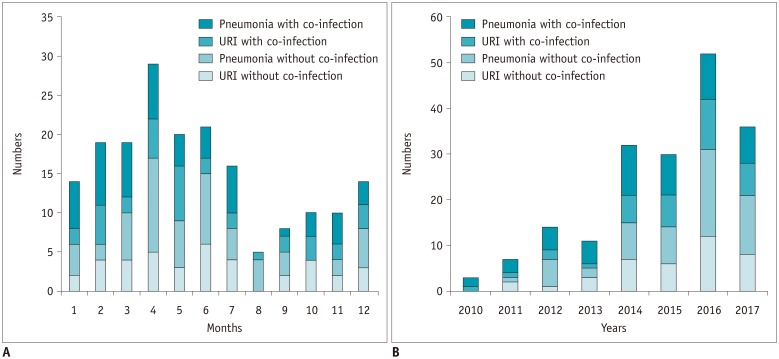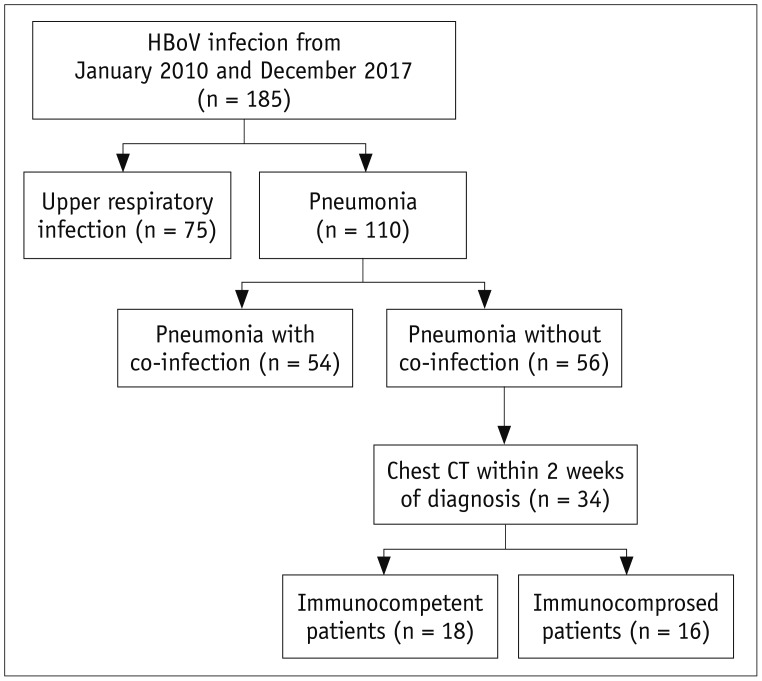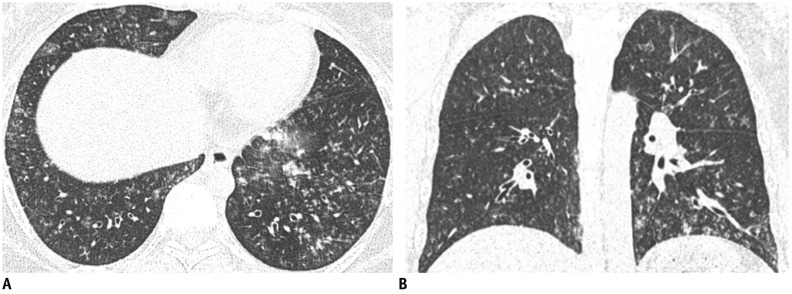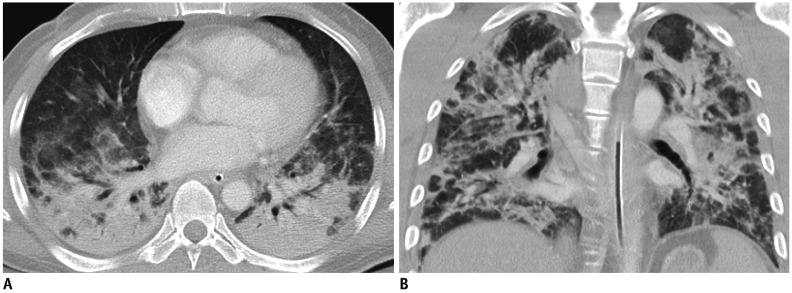Korean J Radiol.
2019 Jul;20(7):1226-1235. 10.3348/kjr.2018.0634.
Human Bocavirus Infection in Adults: Clinical Features and Radiological Findings
- Affiliations
-
- 1Department of Radiology, Kyung Hee University Hospital at Gangdong, College of Medicine, Kyung Hee University, Seoul, Korea.
- 2Department of Radiology and Research Institute of Radiology, Asan Medical Center, University of Ulsan College of Medicine, Seoul, Korea. dokh@amc.seoul.kr
- 3Department of Infectious Diseases, Asan Medical Center, University of Ulsan College of Medicine, Seoul, Korea.
- 4Department of Laboratory Medicine, Asan Medical Center, University of Ulsan College of Medicine, Seoul, Korea.
- KMID: 2467033
- DOI: http://doi.org/10.3348/kjr.2018.0634
Abstract
OBJECTIVE
Human bocavirus (HBoV) is a newly identified pathogen that can cause upper and lower respiratory infections usually in children; however, its clinical characteristics and significance in respiratory infections in adults have not been well known. Our objective was to evaluate the clinical features of respiratory HBoV infection and to describe the CT findings of HBoV pneumonia in adults.
MATERIALS AND METHODS
A total of 185 adult patients diagnosed with HBoV infection at a tertiary referral center between January 2010 and December 2017 were retrospectively evaluated with respect to the clinical characteristics of HBoV infection and its risk factors for pneumonia. Chest CT findings for 34 patients with HBoV pneumonia without co-infection were analyzed and compared between immunocompetent (n = 18) and immunocompromised (n = 16) patients.
RESULTS
HBoV infections were predominantly noted between February and June. Among the 185 patients with HBoV infection, 119 (64.3%) had community-acquired infections and 110 (59.5%) had pneumonia. In multivariable analysis, older age (odds ratio [OR], 1.02; 95% confidence interval [CI], 1.00-1.04; p = 0.045) and nosocomial infection (OR, 2.07; 95% CI, 1.05-4.10; p = 0.037) were associated with HBoV pneumonia. The main CT findings were bilateral consolidation (70.6%) and/or ground-glass opacities (64.7%); centrilobular nodules (14.7%) were found less frequently. The pattern of CT findings were not significantly different between immunocompetent and immunocompromised patients (all, p > 0.05).
CONCLUSION
HBoV infection can be a potential respiratory tract infection in adults. The most frequent CT findings of HBoV pneumonia were bilateral consolidation and/or ground-glass opacities.
Keyword
MeSH Terms
Figure
Reference
-
2. Brieu N, Guyon G, Rodière M, Segondy M, Foulongne V. Human bocavirus infection in children with respiratory tract disease. Pediatr Infect Dis J. 2008; 27:969–973. PMID: 18833027.
Article3. Fry AM, Lu X, Chittaganpitch M, Peret T, Fischer J, Dowell SF, et al. Human bocavirus: a novel parvovirus epidemiologically associated with pneumonia requiring hospitalization in Thailand. J Infect Dis. 2007; 195:1038–1045. PMID: 17330795.
Article4. Pozo F, García-García ML, Calvo C, Cuesta I, Pérez-Breña P, Casas I. High incidence of human bocavirus infection in children in Spain. J Clin Virol. 2007; 40:224–228. PMID: 17904416.
Article5. Zheng LS, Yuan XH, Xie ZP, Jin Y, Gao HC, Song JR, et al. Human bocavirus infection in young children with acute respiratory tract infection in Lanzhou, China. J Med Virol. 2010; 82:282–288. PMID: 20029808.
Article6. Allander T, Tammi MT, Eriksson M, Bjerkner A, Tiveljung-Lindell A, Andersson B. Cloning of a human parvovirus by molecular screening of respiratory tract samples. Proc Natl Acad Sci U S A. 2005; 102:12891–12896. PMID: 16118271.7. Koo HJ, Lim S, Choe J, Choi SH, Sung H, Do KH. Radiographic and CT features of viral pneumonia. Radiographics. 2018; 38:719–739. PMID: 29757717.
Article8. Calvo C, García-García ML, Pozo F, Carballo D, Martínez-Monteserín E, Casas I. Infections and coinfections by respiratory human bocavirus during eight seasons in hospitalized children. J Med Virol. 2016; 88:2052–2058. PMID: 27124519.
Article9. Maggi F, Andreoli E, Pifferi M, Meschi S, Rocchi J, Bendinelli M. Human bocavirus in Italian patients with respiratory diseases. J Clin Virol. 2007; 38:321–325. PMID: 17336143.
Article10. Allander T, Jartti T, Gupta S, Niesters HG, Lehtinen P, Osterback R, et al. Human bocavirus and acute wheezing in children. Clin Infect Dis. 2007; 44:904–910. PMID: 17342639.
Article11. Garbino J, Soccal PM, Aubert JD, Rochat T, Meylan P, Thomas Y, et al. Respiratory viruses in bronchoalveolar lavage: a hospital-based cohort study in adults. Thorax. 2009; 64:399–404. PMID: 19174425.
Article12. Gu K, Van Caeseele P, Dust K, Ho J. Atypical pneumonia due to human bocavirus in an immunocompromised patient. CMAJ. 2017; 189:E697–E699. PMID: 28507089.
Article13. Kupfer B, Vehreschild J, Cornely O, Kaiser R, Plum G, Viazov S, et al. Severe pneumonia and human bocavirus in adult. Emerg Infect Dis. 2006; 12:1614–1616. PMID: 17176591.
Article14. Liu WK, Chen DH, Liu Q, Liang HX, Yang ZF, Qin S, et al. Detection of human bocavirus from children and adults with acute respiratory tract illness in Guangzhou, southern China. BMC Infect Dis. 2011; 11:345. PMID: 22168387.
Article15. Herbst T, Van Deerlin VM, Miller WT Jr. The CT appearance of lower respiratory infection due to parainfluenza virus in adults. AJR Am J Roentgenol. 2013; 201:550–554. PMID: 23971445.
Article16. Micek ST, Kollef KE, Reichley RM, Roubinian N, Kollef MH. Health care-associated pneumonia and community-acquired pneumonia: a single-center experience. Antimicrob Agents Chemother. 2007; 51:3568–3573. PMID: 17682100.
Article17. El Chaer F, Shah DP, Kmeid J, Ariza-Heredia EJ, Hosing CM, Mulanovich VE, et al. Burden of human metapneumovirus infections in patients with cancer: risk factors and outcomes. Cancer. 2017; 123:2329–2337. PMID: 28178369.
Article18. Su YB, Sohn S, Krown SE, Livingston PO, Wolchok JD, Quinn C, et al. Selective CD4+ lymphopenia in melanoma patients treated with temozolomide: a toxicity with therapeutic implications. J Clin Oncol. 2004; 22:610–616. PMID: 14726505.
Article19. Hansell DM, Bankier AA, MacMahon H, McLoud TC, Müller NL, Remy J. Fleischner Society: glossary of terms for thoracic imaging. Radiology. 2008; 246:697–722. PMID: 18195376.
Article20. Lichtenberger JP 3rd, Sharma A, Zachary KC, Krishnam MS, Greene RE, Shepard JA, et al. What a differential a virus makes: a practical approach to thoracic imaging findings in the context of HIV infection--part 1, pulmonary findings. AJR Am J Roentgenol. 2012; 198:1295–1304. PMID: 22623541.21. Miller WT Jr, Mickus TJ, Barbosa E Jr, Mullin C, Van Deerlin VM, Shiley KT. CT of viral lower respiratory tract infections in adults: comparison among viral organisms and between viral and bacterial infections. AJR Am J Roentgenol. 2011; 197:1088–1095. PMID: 22021500.
Article22. Jiang W, Yin F, Zhou W, Yan Y, Ji W. Clinical significance of different virus load of human bocavirus in patients with lower respiratory tract infection. Sci Rep. 2016; 6:20246. PMID: 26832453.
Article23. MacFadden DR, LaDelfa A, Leen J, Gold WL, Daneman N, Weber E, et al. Impact of reported beta-lactam allergy on inpatient outcomes: a multicenter prospective cohort study. Clin Infect Dis. 2016; 63:904–910. PMID: 27402820.
Article24. Walsh EE, Peterson DR, Falsey AR. Human metapneumovirus infections in adults: another piece of the puzzle. Arch Intern Med. 2008; 168:2489–2496. PMID: 19064834.25. Koo HJ, Lee HN, Choi SH, Sung H, Oh SY, Shin SY, et al. Human metapneumovirus infection: pneumonia risk factors in patients with solid organ transplantation and computed tomography findings. Transplantation. 2018; 102:699–706. PMID: 28957844.26. Kim EA, Lee KS, Primack SL, Yoon HK, Byun HS, Kim TS, et al. Viral pneumonias in adults: radiologic and pathologic findings. Radiographics. 2002; 22 Spec No:S137–S149. PMID: 12376607.
Article
- Full Text Links
- Actions
-
Cited
- CITED
-
- Close
- Share
- Similar articles
-
- Human Bocavirus in Patients with Respiratory Tract Infection
- Epidemiologic Characteristics of Human Bocavirus-Associated Respiratory Infection in Children
- Clinical characteristics of respiratory viral infection in children during spring/summer: focus on human bocavirus
- Phylogenetic Analysis of Human Bocavirus in Hospitalized Children with Acute Respiratory Tract Infection in Korea
- Clinical manifestation of human bocavirus infection in children





